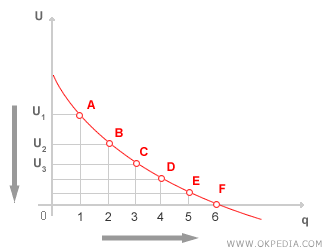Utility
Utility refers to the satisfaction or benefit an individual derives from consuming a good or service that fulfills a specific need. In economic terms, utility is the capacity of a good or service to meet a human economic want. It is not an inherent property of the good itself-rather, utility is a subjective concept, as it varies from person to person. It depends on the relationship between a particular need and a good’s ability to satisfy it. If that relationship doesn’t exist, or the individual is unaware of it, the good cannot be said to have economic utility. Economic utility refers to the actual or perceived suitability of a good to satisfy a need. As such, its existence is inseparable from the presence of an economic want. Utility diminishes progressively as the need is satisfied and disappears altogether once the need is fully met. Moreover, utility is relative-it depends on the nature of the good or service, its scarcity, and how much of it the individual has already consumed (known as relative utility). The scarcer a good is relative to a pressing need, the greater its utility will be. We can distinguish between the following types of utility:
- Initial utility. This refers to the utility gained from consuming the first unit of a good or service.
- Marginal utility. Marginal utility is the additional satisfaction obtained from consuming one more (infinitesimal) unit of a good. It represents the utility of the last unit consumed. Marginal utility typically decreases with each additional unit-a principle known as diminishing marginal utility. The first unit tends to yield the greatest benefit, while subsequent units offer progressively less. Eventually, marginal utility falls to zero once the need is fully satisfied.
- Total utility. Total utility is the cumulative satisfaction obtained from consuming a certain quantity of a good or service. It is the sum of the utility derived from each unit consumed.
The first unit consumed (A) delivers a high level of initial utility (U1). The second unit (B) yields a lower level of utility (U2) than the first, and the pattern continues. According to the law of satiable needs, the intensity of a need decreases as it is progressively satisfied. By the sixth unit (F), the need has been entirely met, and marginal utility drops to zero. Any consumption beyond this point leads to negative utility-producing discomfort or dissatisfaction.

The concept of utility has evolved across different schools of economic thought. In classical economics, utility was primarily associated with a good’s use-value. Only goods that could satisfy a need were considered to have positive exchange value. Classical economists linked a good’s exchange value to its cost of production (especially labor costs), while use-value (utility) was regarded as a qualitative judgment made by the buyer. In the late 19th century, the marginalist school introduced the notion of subjective utility and drew a distinction between total and marginal utility.
 Measuring Utility. In the 19th century, economists regarded utility as a measurable quantity (cardinal utility). However, the difficulty of identifying an objective, universal utility function capable of assigning absolute numerical values to levels of satisfaction led economists to adopt a more comparative approach. Utility came to be viewed as an ordinal concept (ordinal utility), used to rank preferences rather than measure them precisely.
Measuring Utility. In the 19th century, economists regarded utility as a measurable quantity (cardinal utility). However, the difficulty of identifying an objective, universal utility function capable of assigning absolute numerical values to levels of satisfaction led economists to adopt a more comparative approach. Utility came to be viewed as an ordinal concept (ordinal utility), used to rank preferences rather than measure them precisely.
 Diminishing Marginal Utility. One of the most important characteristics of utility is that it tends to decline as more of a good is consumed. According to the law of diminishing marginal utility, the benefit derived from each additional unit of a good decreases as consumption increases, because the urgency of the underlying need weakens. For example, the first glass of water is extremely valuable to a thirsty person, but additional glasses become progressively less satisfying. Eventually, when thirst is fully quenched, further consumption provides zero utility-or in some cases, may even lead to negative utility (disutility). The following diagram illustrates how marginal utility behaves.
Diminishing Marginal Utility. One of the most important characteristics of utility is that it tends to decline as more of a good is consumed. According to the law of diminishing marginal utility, the benefit derived from each additional unit of a good decreases as consumption increases, because the urgency of the underlying need weakens. For example, the first glass of water is extremely valuable to a thirsty person, but additional glasses become progressively less satisfying. Eventually, when thirst is fully quenched, further consumption provides zero utility-or in some cases, may even lead to negative utility (disutility). The following diagram illustrates how marginal utility behaves.
